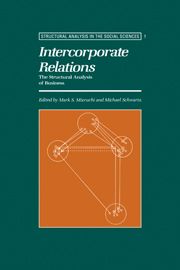Book contents
- Frontmatter
- Contents
- List of figures
- List of tables
- Introduction
- I Theoretical perspectives
- II National and international business structures: a comparative perspective
- 6 The structure of class cohesion: the corporate network and its dual
- 7 Intercorporate structures in Western Europe: a comparative historical analysis
- 8 The articulation of power and business structures: a study of Colombia
- 9 Business–government relations in modern Japan: a Tōdai–Yakkai–Zaikai complex?
- 10 International bank capital and the new liberalism
- Index of authors
- Subject index
9 - Business–government relations in modern Japan: a Tōdai–Yakkai–Zaikai complex?
Published online by Cambridge University Press: 04 February 2010
- Frontmatter
- Contents
- List of figures
- List of tables
- Introduction
- I Theoretical perspectives
- II National and international business structures: a comparative perspective
- 6 The structure of class cohesion: the corporate network and its dual
- 7 Intercorporate structures in Western Europe: a comparative historical analysis
- 8 The articulation of power and business structures: a study of Colombia
- 9 Business–government relations in modern Japan: a Tōdai–Yakkai–Zaikai complex?
- 10 International bank capital and the new liberalism
- Index of authors
- Subject index
Summary
Analysis of Japanese business–government relations is facilitated if we accept a working hypothesis at the outset: that business and government in Japan are like two major divisions of a well-run organization – Japan itself. Although some versions of “Japan, Inc.” are generally considered extreme by many Japan specialists, there is no doubt that the Japanese have long accepted the concept of a “corporatist unity of government and business.” (kanmin ittai) for the attainment of national goals.
In this chapter, we intend to show how the personal networks and contacts of public officials and private business leaders render the formal structural distinction of government and business almost meaningless in Japan.
A simple model of the TYZ complex
In order to facilitate the interpretation and appreciation of detailed data presented in this chapter, we first offer a simple model showing how individuals with business leadership qualities go through life cycles and interact with one another in the management of Japan as a close-knit business-oriented society. Executive positions of leading corporations (the Japanese counterpart of “Fortune 500”) are occupied predominantly by graduates of Tokyo University (Tōdai) and four other prestigious universities (Kyōto, Hitotsubashi, Keiō, and Waseda). The graduates of these universities also dominate leading bureaucratic positions in national government. Bureaucrats retire early, and many join leading corporations. A great majority of these bureaucratic and business leaders originate in middle- and upper-class families.
- Type
- Chapter
- Information
- Intercorporate RelationsThe Structural Analysis of Business, pp. 264 - 297Publisher: Cambridge University PressPrint publication year: 1988



